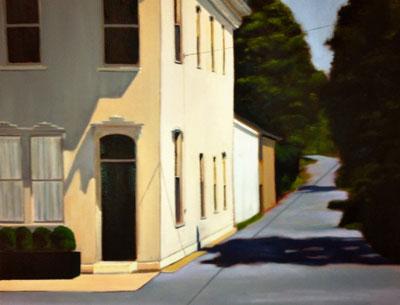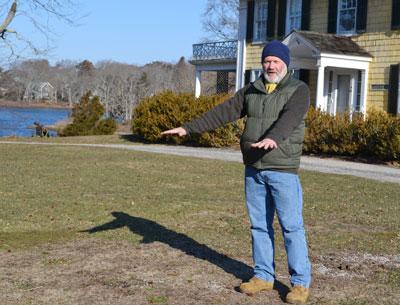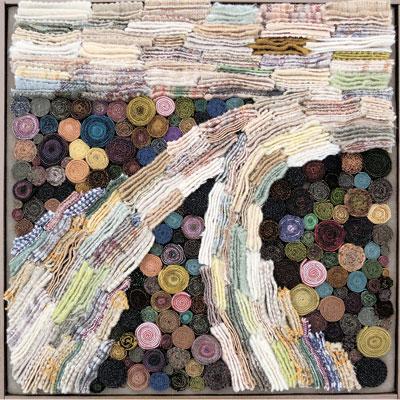The Art Scene: 03.28.13
The Art Scene: 03.28.13

To Fool the Eye
Todd Norsten will be featured in the solo show “This Isn’t How It Looks” at Glenn Horowitz Bookseller in East Hampton beginning Saturday with a reception from 6 to 8 p.m.
According to the gallery, Mr. Norsten expends a lot of energy making it look like he didn’t in his minimalist and text-based paintings. The gallery will show 25 works from 2010 to 2013, many of which feature “meticulous trompe l’oeil depictions of mundane materials like Scotch and blue painter’s tape . . . with bits of dust, fingerprints, and ragged edges.”
The artist was born in Minnesota in 1967, and still lives and works there. He has exhibited at galleries and museums in the United States, Europe, and Asia, including the Walker Art Center, Minneapolis, and was included in the 2006 Whitney Biennial. His work is in the collections of the British Museum, the Minneapolis Institute of Arts, and the Walker Art Center.
The exhibition will be on view through May 18.
Everybody’s Talking About Larry
To commemorate its acquisition of the Larry Rivers archive, New York University is hosting a daylong symposium dedicated to the way the artist refused to be bound to just one medium of expression.
“Crossings: Larry Rivers and His Milieu” will be presented by Carol A. Mandel, dean of the school’s division of libraries, and David Joel, the executive director of the Larry Rivers Foundation, tomorrow from 9 a.m. to 5:30 p.m. at the Fales Library and Special Collections in the Bobst Library at 70 Washington Square South in New York City. A reception will follow in the Tracey/Barry gallery in the library, which is presenting Rivers’s work in a show of the same title.
The panel discussions, four in all, will look at Rivers’s art, his literary and social circles, his poetry, and his performance of jazz saxophone with experts from each field and those who knew him.
Harper’s Bizarre Redux
Going bizarre in winter was not enough for Harper’s Books, so the East Hampton gallery and photography book dealer has decided to do it again on Saturday with a live auction, party, and exhibition opening that will begin at 10 a.m. and continue all day, with the party from 7 p.m. on.
The exhibition on view will be Matt Weber’s third show at Harper’s Books. A black-and-white film photographer, Mr. Weber’s subject is the constantly changing New York street scene. His devotion to analog photography reminds viewers of Henri Cartier-Bresson’s “decisive moment” in an era otherwise devoted to digital manipulation.
The preview of the “mystery auction” will begin in the morning. The auction will include books, photographs, posters, artworks, and odds and ends, starting at affordable opening bids. The items will only be available for viewing the day of the auction. The auction will start at 6 p.m. and will be followed by an after-party with food, drinks, and more book deals, priced from $5 up. Mister Lama will serve as DJ.
Academy in Cheek
Romany Kramoris Gallery in Sag Harbor will present work by four members of “The Academy,” a group with a slightly irreverent take on the realist painting tradition, beginning today, with a reception on Saturday from 4 to 6 p.m.
Those exhibited will be Thomas Condon, Pingree Louchheim, Joan Tripp, and Richard Udice. The show will be on view through April 25.
Mr. Condon, a part-time East Hampton resident, focuses on landscapes both rural and urban and stresses shadow and light in his work. Ms. Louchheim, who lives in Sagaponack, will feature her owl series, realistic yet personalized depictions of the snowy owl, barn owl, and long-eared owl, and other works. Ms. Tripp will show her renditions of the gaseous, ephemeral, celestial delicacy, and lightness of the nebulae captured by the Hubble Space Telescope, along with her East End landscapes. Mr. Udice paints landscapes in oil in an Impressionistic style with a muted palette and a somber and mysterious tone.
Romany Kramoris Gallery is open Friday through Tuesday from 11 a.m. to 7 p.m., later on weekends.
Wednesday on the Weekend
The Wednesday Group will show their plein-air paintings at Ashawagh Hall in Springs this weekend with a reception on Saturday from 5 to 8 p.m.
The show is titled “Points of View Large and Small” and features the work of Anna Franklin, Peter Gumpel, Cynthia Loewen, Deb Palmer, Alyce Peifer, Gene Samuelson, Christine Chew Smith, Frank Sofo, Cynthia Sobel, and Pam Vossen.




